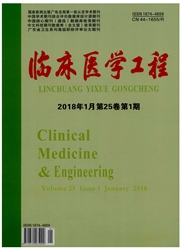

 中文摘要:
中文摘要:
目的 比较应用WHO倡导的脐带暴露法与传统的脐带包扎法对预防新生儿脐部感染和脐带残端脱落时间长短的影响.方法 选择2012年10月至11月住院分娩的356例新生儿,随机分为脐带暴露法组与脐带包扎法组,两组脐带结扎方法相同,脐带暴露法组断脐后在产房开始即暴露脐带,日常护理用清水清洁脐部,不用任何消毒液;脐带包扎法组断脐后使用脐带卷包扎,日常护理仍然使用75%酒精消毒脐部并每日包扎.比较分析两组新生儿脐带残端脱落时间、脱落率、脐部分泌物及脐炎发生率情况.结果 脐带暴露法组脐带残端脱落时间多集中在6~7天,而脐带包扎法组多在7天以上,两组脱落率分别有显著差异(P<0.01);脐带暴露法组脐部分泌物和轻度脐炎发生率明显低于脐带包扎法组(P<0.01和P<0.05).结论 采用脐带暴露法可明显缩短脐带残端脱落时间,并能降低脐部感染率,是一种安全有效的新生儿脐部护理方法.
 英文摘要:
英文摘要:
Objective To compare the clinical effect between umbilical cord exposure and tradition umbilical cord bandage method in the prevention of neonatal umbilical region infection and umbilical departure time. Methods From Octomber to November 2012, 356 neonates were randomized into umbilical cord exposure group and umbilical cord bandage group. After ligature of the cord, umbilical cord exposure group received WHO "dry and clean" protocol that the umbilical cord was exposed to air (with loosing clothes), cleaned by clear water instead of alcohol; umbilical cord bandage group used tradition method that the umbilical cord and surrounding skins were sterilized with 75% alcohol and dressing. Umbilical departure time, expulsion rate, navel region secretion and the rate of omphalitis were analyzed. Results The umbilical cord departed majorly at 6 to 7 days in the umbilical cord exposure group, and the umbilical cord bandage group departed majorly more than 7 days, with statistically significant difference in umbilical departure time (P 〈0.01). The condition of navel region secretion and the rate of omphalitis show that umbilical cord exposure group was obviously lower than the umbilical cord bandage group (P 〈0.01, P 〈0.05). Conclusions Navel exposure is a safe and effective method that can shorten umbilical departure time and reduce the rate of umbilical region infection.
 同期刊论文项目
同期刊论文项目
 同项目期刊论文
同项目期刊论文
 期刊信息
期刊信息
